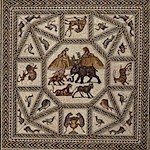By G.W. BOWERSOCK [New York Review of Books] – It’s not easy to make sense of the remarkable Lod Mosaic, a large, ancient floor newly discovered in Israel and now on display in the United States for the first time at the Metropolitan Museum of Art. But the very difficulty of interpretation, together with the excellent state of preservation, is what makes it so fascinating. We simply don’t know whether it was part of a residence or an official building, and we can’t even say whether the owner or owners were Jewish, Christian, or pagan. The date is not secure either, although the excavator proposes about AD 300 because late third-and-fourth-century coins and ceramic scraps were found immediately above it. Miraculously, what is on display at the Met survived intact apart from one large gash near the bottom that the excavator considers ancient damage, although not everyone agrees.
The mosaic at the Met is the main part of an ensemble of floor mosaics that the Israeli Antiquities Authority uncovered in 1996 at Lod (ancient Lydda) during the construction of a road between Tel Aviv and Jerusalem. (The other fragments from the same floor have not come to the United States but can be viewed online.)
Continued at The New York Review of Books | more Chronicle & Notices.






















Post a Comment